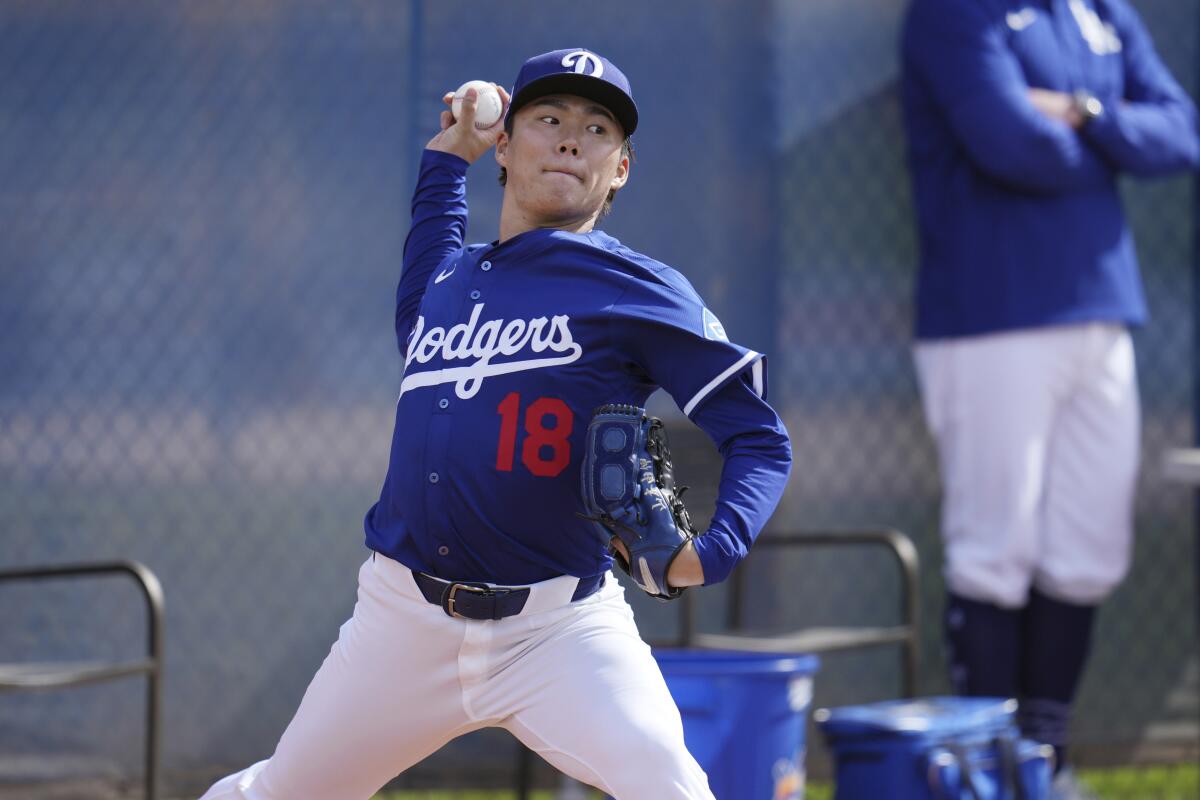Yoshinobu Yamamoto excited for likely opening day start in Japan, but has bigger goals

- Share via
PHOENIX — Last year, Yoshinobu Yamamoto’s season debut was a cause for alarm.
This year it will signal just how much trust the Japanese right-hander has earned entering his second season with the Dodgers.
Even though the team added a two-time Cy Young Award in Blake Snell, a 23-year-old phenom in Roki Sasaki, and returns last year’s opening day starter, Tyler Glasnow, manager Dave Roberts announced this week that it likely will be Yamamoto who gets the ball in the season opener next month in Japan.
“I’m very looking forward to it, to be able to pitch, perform at the Japanese ballpark again,” Yamamoto said Thursday through interpreter Yoshihiro Sonoda. “And I’d like to get myself ready the best I can.”
Follow along for the latest news as the Dodgers open spring training at Camelback Ranch in Phoenix following their World Series-winning campaign.
Granted, the setting of the series might have influenced the decision. Yamamoto likely will face Shota Imanaga of the Cubs in the opener at the Tokyo Dome. When Chicago manager Craig Counsell was asked about his decision to start his Japanese star, Counsell joked, “I don’t think I have a choice.”
With Yamamoto, however, the honor also reflects the strides he made in his rookie season, which started with a disastrous debut in South Korea against the San Diego Padres, was nearly derailed by a midseason shoulder injury that sidelined him for almost three months, and ended with the diminutive flamethrower emerging as the Dodgers’ most consistent starter during their postseason run to a World Series title.
“I learned a lot from all the experiences last year,” Yamamoto said after posting a 7-2 record and 3.00 earned-run average in 18 regular-season outings, then a 3.86 ERA in four playoff starts, all victories.
“That kind of helped me to adjust to what I was doing before, and what I needed to do” to be successful in the majors, Yamamoto added.
It was a year of transformation for Yamamoto, who signed a record-breaking $325-million contract last offseason after winning three most valuable player awards in Japan’s Nippon Professional Baseball league.
In his MLB debut in South Korea, he was knocked around for five runs in one inning. His performance over the rest of the first half of the season featured more inconsistencies, with Yamamoto struggling with everything from pitch-tipping to unusually shaky command of the strike zone.

The low point came after a stellar seven-inning shutout performance against the New York Yankees in June, when Yamamoto suffered a strained rotator cuff. For the next three months, he was on the injured list. And his availability for October remained in doubt.
In the end, though, Yamamoto not only returned to action in time for the playoff run, but also looked increasingly comfortable in his new surroundings. His pinpoint fastball command returned. His use of a signature splitter and curveball kept hitters off balance. And in his final start, in a pivotal Game 2 of the World Series, Yamamoto dominated the Yankees again, giving up just one run and one hit over 6 ⅓ innings.
“Obviously, on this stage, he was fantastic,” Roberts said that night.
Yamamoto’s goal is to make such gems a more common occurrence, with the 26-year-old aiming to remain healthy and consistent as one of several frontline options in the loaded, new-look rotation.
“This is my second year, so it’s a little more comfortable,” Yamamoto said. “I like to enjoy the new guys this one month through spring training and then get myself ready for the games.”
Yamamoto, whose javelin-based training routine became a point of fascination last spring, said he didn’t change much in his offseason program. But this spring he does occupy a slightly different role in the clubhouse, serving as something of a mentor for Sasaki as he embarks on a similar transition from Japan.
“I’m very happy to have him on the same team with us,” Yamamoto said of Sasaki, a former teammate on Japan’s 2023 World Baseball Classic squad whom Yamamoto helped recruit this winter.
Roki Sasaki has the talent to be an instant sensation the way Fernando Valenzuela or Hideo Nomo were in previous generations. But he could just as easily become the Japanese Bobby Miller.
Will there be any rookie hazing?
“Not at this point so far,” Yamamoto answered with a laugh. “But probably.”
As far as opening day is concerned, Yamamoto said a potential matchup against Imanaga — who also debuted in the majors last year, earning an All-Star selection with a 15-3 record and 2.91 ERA — would be “very exciting” for him and fans across Japan. But he has bigger goals, trying to use the lessons he learned early in his rookie campaign to author a more complete sophomore season in the majors.
“Last year I spent three months rehabilitating,” Yamamoto said in Japanese. “This year I want to do my best to contribute to the team for the entire season and to become world champions again.”
More to Read
Are you a true-blue fan?
Get our Dodgers Dugout newsletter for insights, news and much more.
You may occasionally receive promotional content from the Los Angeles Times.







